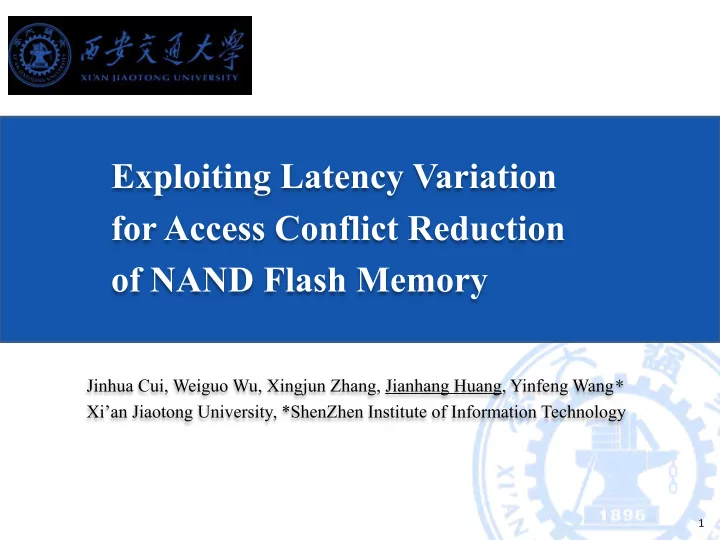

Exploiting Latency Variation for Access Conflict Reduction of NAND Flash Memory Jinhua Cui, Weiguo Wu, Xingjun Zhang, Jianhang Huang, Yinfeng Wang * Xi’an Jiaotong University, *ShenZhen Institute of Information Technology 1
OUTLINE 1. Background and Motivation 2. Design of RHIO 3. Evaluations 4. Conclusions 2 2
NAND Flash Memory NAND Flash Memory Trends Flash Cell Size Trends Source: Flash Memory Summit Source: ISSCC’16 Tech. Trends Cell size Write RBER Tradeoff Bit/cell Read 3
Tradeoff: RBER, Write, Read (1/4) • ECC complexity, ECC capability and read speed ̶ Soft-decision memory sensing ̶ Sensing levels preciser memory sensing (stronger ECC capability) ̶ Sensing levels less reference voltage (faster read) 4
Tradeoff: RBER, Write, Read (2/4) • RBER, program step size and write speed ̶ Incremental step pulse programming (ISPP) ̶ V p fewer steps (faster write) ̶ V p preciser control on V th (lower RBER) 5
Tradeoff: RBER, Write, Read (3/4) • Process Variation (PV) ̶ Different worst-case RBER under the same P/E cycling ̶ Strong block lower RBER ̶ Weak block higher RBER Source: Pan et al, “Error Rate-BasedWear-Leveling for NAND Flash Memory at Highly Scaled Technology Nodes” 6
Tradeoff: RBER, Write, Read (4/4) • Retention Age Variation ̶ The length of time since a flash cell was programmed ̶ Short age lower RBER ̶ Long age higher RBER Source: Liu et al, “Optimizing NAND Flash-Based SSDs via Retention Relaxation”, Fast 2012 7
Motivation • Process Variation different blocks Speed variation • Retention Variation different data Our work is focused on here 8
Design of RHIO
Main idea of RHIO • Observation ̶ If a tradeoff-aware technique improves I/O performance based on the variation characteristic of an attribute, the detection of the attribute can be implemented in I/O scheduling and thus the tradeoff induced speed variation can be exploited for maximal benefit by giving scheduling priority to fast writes and fast reads. • Techniques ̶ Process variation based fast write ̶ Retention age based fast read ̶ Shortest-job-first scheduling 10
Hotness-aware Write Scheduling • Put hot data in strong blocks using fast write , and non- hot data into normal blocks with normal writes • Give scheduling priority to hot write requests to reduce the conflict latency of next few requests in the queue • Use the size of IO requests to identify hotness 11
Hotness-aware Write Scheduling Lower size (Higher hotness) • Read-write separation • Hotness Groups are issued in the order of hotness 12
Retention-aware Read Scheduling • Perform fast read (less sensing levels) on the data with low retention ages • Give scheduling priority to reads accessing data with low retention ages to reduce the conflict latency of next few requests in the queue • Retention age identification by extending each mapping entry in the FTL with a timestamp field and recording the timestamp when data is programmed 13
Retention-aware Read Scheduling R3 newest the first to be issued • Write: size-based predicted hotness Read: retention-based actual hotness • Write: discrete size hotness groups Read: consecutive retention age red-black tree • Deadline FIFO queue SATA interface PRIO: 01b, ICC: deadline value 14
Evaluations
Evaluation and Discussions • A trace-driven simulator is used to verify the proposed algorithm. • Traces include a set of selected MSR Cambridge traces from SNIA. • Comparison among: NOOP, PV-W, RH-R, RHIO. ̶ NOOP: Traditional I/O Scheduler ̶ PV-W: PV-aware write performance improvement without conflict-aware reordering. ̶ RH-R: Retention-aware read performance improvement without reordering I/O requests sequence. ̶ RHIO: Our proposed I/O scheduler. 16
Read Performance Latency Ratio Noncritical Performance Movement Improvement • RHIO vs. NOOP: 39.11% • RHIO vs. RT-R: 7.04% 17
Write Performance Latency Performance Improvement Ratio Noncritical Movement • RHIO vs. PV-W: 7.12% • RHIO vs. NOOP: 29.92%
Conclusions
Conclusions • Proposed an I/O scheduler (RHIO) to exploit latency variation for access conflict reduction of NAND flash memory. ̶ Hotness-aware write scheduling: give scheduling priority to hot write requests and allocate their data to strong blocks with fast write. ̶ Retention-aware read scheduling: give scheduling priority to read requests which access data with low retention ages using fast read. • Experimental results show that the proposed approach is very efficient in performance improvement. 20
cjhnicole@gmail.com 21
Recommend
More recommend